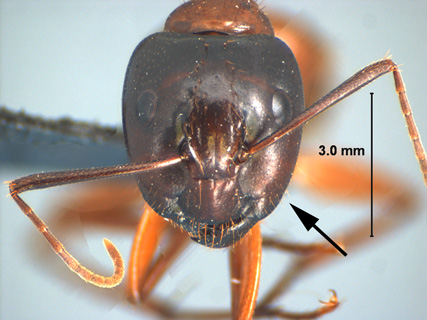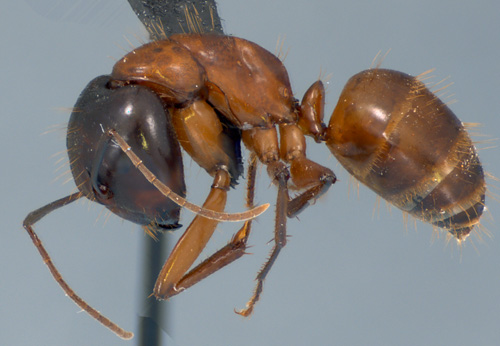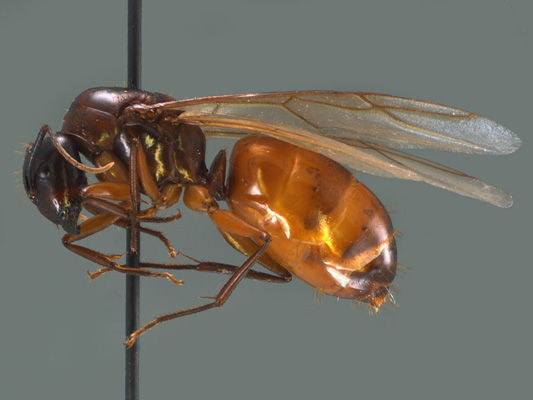Subfamily FORMICINAE |
|||
Camponotus americanus, full face view of major worker. The arrow points to erect hairs found on the gena (cheek), especially seen in the major worker. This differs from C. castaneus, a similar looking species which lacks the erect hairs on the gena (Photo by Joe A. MacGown). |
Camponotus americanus, profile view of major worker. The dark head and mottled brown coloration on the alitrunk dorsum is typical for this area (compare to C. castaneus) (Photo by Joe A. MacGown) . |
Camponotus americanus, profile view of alate queen (Photo by Joe A. MacGown) |
|
Camponotus americanus, profile view of major worker (Photo by Joe A. MacGown) |
|||
Introduction Taxonomic History Diagnosis Identification Worker: Large, 7-10 mm (TL). Head black to brownish-black; mesosoma and gaster yellow-brown, mesosomal dorsum often infuscated. Cheeks with numerous erect hairs (especially in major workers); scape extends beyond pastor edge of head by more than diameter of scape, at least the distance of the first funicular segment or more; scape not flattened at base; head of major longer than wide. Gaster shiny, pubescence mostly lacking. Female: Similar to worker, but larger. Coloration similar, but mesosoma often dark reddish-brown. This species could be easily confused with C. castaneus (Latreille), a similarly colored and sized carpenter ant that invades houses and other buildings with more regularity (although not commonly). Camponotus americanus can be distinguished from C. castaneus by its darker head and erect hairs on the cheeks. In C. castaneus the head is the same orangish-red color as the rest of the body, and the cheeks (especially as seen in the major workers) lack erect hairs. Southeastern specimens often have spots of darker coloration on the dorsum of the mesosoma on C. americanus, whereas in C. castaneus, the coloration is much more uniform without any mottling or spots of other colors. Biology and Economic Importance Pest Status Distribution Species Distribution Map Acknowledgements Literature Cited Bolton, B. 1995. A new general catalogue of the ants of the world. Cambridge, Mass.: Harvard University Press, 504 pp. Creighton, W. S. 1950. The ants of North America. Bull. Mus. Comp. Zool. 104: 1-585. Eisner, T. and Wilson, E. O. 1952. The morphology of the proventriculus of a formicine ant. Psyche (Camb.) 59: 47-60. Emery, C. 1893. Beiträge zur Kenntniss der nordamerikanischen Ameisenfauna. Zool. Jahrb. Abt. Syst. Geogr. Biol. Tiere 7: 633-682. Emery, C. 1925. Hymenoptera. Fam. Formicidae. Subfam. Formicinae. Genera Insectorum 183: 1-302. Mayr, G. 1862. Myrmecologische Studien. Verh. K-K. Zool.-Bot. Ges. Wien 12: 649-776 Mayr, G. 1886. Die Formiciden der Vereinigten Staaten von Nordamerika. Verh. K-K. Zool.-Bot. Ges. Wien 36: 419-464. Wheeler, G. C. and Wheeler, J. 1968. The ant larvae of the subfamily Formicinae (Hymenoptera: Formicidae): supplement. Ann. Entomol. Soc. Am. 61: 205-222. Wheeler, W. M. 1913. Ants collected in Georgia by Dr. J. C. Bradley and Mr. W. T. Davis. Psyche (Camb.) 20: 112-117. Wheeler, W. M. 1917. A list of Indiana ants. Proc. Indiana Acad. Sci. 26: 460-466. Wheeler, W. M. 1932. A list of the ants of Florida with descriptions of new forms. J. N. Y. Entomol. Soc. 40: 1-17. Links |
|||






